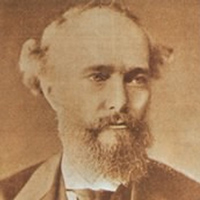 St Patrick’s Cathedral, Melbourne, Victoria
St Patrick’s Cathedral, Melbourne, Victoria
The nineteenth-century Gothic Revival Cathedral of St Patrick’s, Melbourne, Victoria (1858-1899, 1930s, 1970s, 1990s) is a place for Christian worship. It is a house of prayer, a dwelling-place of the Lord among God’s people. St Patrick’s has been part of my life since before I was born. In 1950, my Swiss-Polish parents, new post-WWII immigrants, were married in the cathedral sacristy by a Polish priest. The architect of the cathedral, William Wilkinson Wardell (1823-1899), became the topic of my doctoral research in the 1980s; and in the early 2000s my youngest daughter was married in the cathedral. It was in the 1990s that I began visiting the Ladye Chapel whenever I was in Melbourne. My younger brother was diagnosed with cancer in his mid-twenties and I found great comfort in simply being present with Mary, mother of us all.
Continue reading “WILLIAM WARDELL’S LADYE CHAPEL”
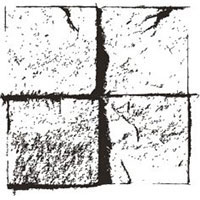 Jubilee of Artists – 15-18 February 2025
Jubilee of Artists – 15-18 February 2025
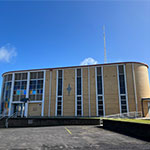 Returning to Blairgowrie, Victoria, from a road trip to Kangaroo Island in September 2022, we stopped in the town of Millicent, SA, to pick something up on the way. Serendipitously we parked in front of the catholic church of St Alphonsus.
Returning to Blairgowrie, Victoria, from a road trip to Kangaroo Island in September 2022, we stopped in the town of Millicent, SA, to pick something up on the way. Serendipitously we parked in front of the catholic church of St Alphonsus.  Alan Sumner mbe (1911-1994) was a painter, printmaker, teacher and stained-glass designer. After studying at the NGV school, RMIT and the George Bell School in the early 1930s, Sumner travelled to Europe and the UK, furthering his training at the Grand Chaumière and the Courtauld Institute. Returning to Melbourne, he took up an apprenticeship as a stained-glass designer with Brooks Robinson before becoming a designer for Yenckens. He taught painting at the NGV school from 1947 to 1950 and spent nine years as Head of School from 1953 onward. Meanwhile, over the course of his career he completed approximately 100 commissions for windows in Melbourne and internationally. (National Portrait Gallery, Canberra, 2018).
Alan Sumner mbe (1911-1994) was a painter, printmaker, teacher and stained-glass designer. After studying at the NGV school, RMIT and the George Bell School in the early 1930s, Sumner travelled to Europe and the UK, furthering his training at the Grand Chaumière and the Courtauld Institute. Returning to Melbourne, he took up an apprenticeship as a stained-glass designer with Brooks Robinson before becoming a designer for Yenckens. He taught painting at the NGV school from 1947 to 1950 and spent nine years as Head of School from 1953 onward. Meanwhile, over the course of his career he completed approximately 100 commissions for windows in Melbourne and internationally. (National Portrait Gallery, Canberra, 2018).  Windows for God’s Light
Windows for God’s Light On Monday 11 January 2020, the last of the pieces of furniture were delivered for the refurbishment and reordering of the Rosebank Chapel. These are the primary pieces that will become sacred in the coming years as we, the People of God, do the ritual acts of
On Monday 11 January 2020, the last of the pieces of furniture were delivered for the refurbishment and reordering of the Rosebank Chapel. These are the primary pieces that will become sacred in the coming years as we, the People of God, do the ritual acts of  Melbourne architect GREGORY BURGESS (b. 1945) is known internationally for public architecture which both expresses the spiritual and creates a unifying communal experience. His work has included arts and visitor centres, educational and health facilities.
Melbourne architect GREGORY BURGESS (b. 1945) is known internationally for public architecture which both expresses the spiritual and creates a unifying communal experience. His work has included arts and visitor centres, educational and health facilities.  St Patrick’s Cathedral, Melbourne, Victoria
St Patrick’s Cathedral, Melbourne, Victoria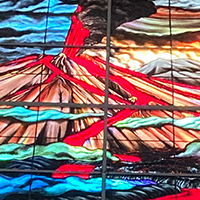 Embracing local holidays in Queensland recently, I found myself in St Monica’s Cathedral in Cairns for the first time in over twenty-five years. I was at last able to behold the magnificent creation windows made in the second half of the 1990s by Gerry Cummins and Jill Stehn. There are twelve windows on each side of the nave, each one measuring 6.5 metres by 1.6 metres. They are a monumental presentation of the Genesis story of the creation of the world, and include many scientific elements in the design together with frequent visual references to the Cairns topography, flora and fauna. They create a dynamic context for liturgy which is both cosmic and local.
Embracing local holidays in Queensland recently, I found myself in St Monica’s Cathedral in Cairns for the first time in over twenty-five years. I was at last able to behold the magnificent creation windows made in the second half of the 1990s by Gerry Cummins and Jill Stehn. There are twelve windows on each side of the nave, each one measuring 6.5 metres by 1.6 metres. They are a monumental presentation of the Genesis story of the creation of the world, and include many scientific elements in the design together with frequent visual references to the Cairns topography, flora and fauna. They create a dynamic context for liturgy which is both cosmic and local. The Art and Architecture Committee of Sacred Heart Parish, Sandringham.
The Art and Architecture Committee of Sacred Heart Parish, Sandringham.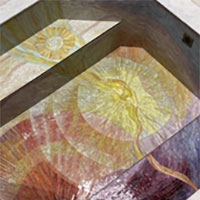 The inspiration of St Francis Xavier Cathedral in Geraldton, Western Australia, considered by some as one of the finest cathedrals built in the 20th century
The inspiration of St Francis Xavier Cathedral in Geraldton, Western Australia, considered by some as one of the finest cathedrals built in the 20th century